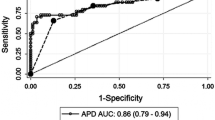Abstract
Successful management of hydronephrosis in the newborn requires early accurate diagnosis to identify or exclude ureteropelvic junction obstruction. However, the presence of hydronephrosis does not define obstruction and displays unique behavior in the newborn. The hydronephrotic kidney usually has nearly normal differential renal function at birth, has not been subjected to progressive dilation and except for pelvocaliectasis does not often show signs of high-grade obstruction. Furthermore, severe hydronephrosis resolves spontaneously in more than 65% of newborns with differential renal function stable or improving. The diagnosis of obstruction in newborn hydronephrosis is challenging because the currently available diagnostic tests, ultrasonography and diuretic renography have demonstrated inaccuracy in diagnosing obstruction and predicting which hydronephrotic kidney will undergo deterioration if untreated. Accurate diagnosis of obstruction is possible but it requires an understanding of the uniqueness of both the pathophysiology of obstruction and the biology of the kidney and renal collecting system in this age group. We examine here the requirements for making an accurate diagnosis of obstruction in the young child with hydronephrosis.








Similar content being viewed by others
References
Tripp BM, Homsy YL (1995) Neonatal hydronephrosis—the controversy and the management. Pediatr Nephrol 9:503–509
Ransley PG, Dhillon HK, Gordon I et al (1990) The postnatal management of hydronephrosis diagnosed by prenatal ultrasound. J Urol 144(2 Pt 2):584–587
Koff SA, Campbell KD (1994) The nonoperative management of unilateral neonatal hydronephrosis: natural history of poorly functioning kidneys. J Urol 152:593–595
Ulman I, Jayanthi VR, Koff SA (2000) The long-term follow-up of newborns with severe unilateral hydronephrosis initially treated nonoperatively. J Urol 164:1101–1105
Chung YK, Chang PY, Lin CJ et al (1992) Conservative treatment of neonatal hydronephrosis. J Formos Med Assoc 91:75–80
Nonomura K, Yamashita T, Kanagawa K et al (1994) Management and outcome of antenatally diagnosed hydronephrosis. Int J Urol 1:121–128
Dhillon HK (1998) Prenatally diagnosed hydronephrosis: the Great Ormond Street experience. Br J Urol 81 [Suppl 2]:39–44
Koff SA (1990) Pathophysiology of ureteropelvic junction obstruction. Clinical and experimental observations. Urol Clin N Am 17:263–272
Koff SA (1981) Diagnosis of obstruction in experimental hydroureteronephrosis: mechanisms for progressive urinary tract dilation. Invest Urol 19:85–88
Koff SA (1983) Determinants of progression and equilibrium in hydronephrosis. Urology 21:496–500
Koff SA (1985) Pressure volume relationships in human hydronephrosis. Urology 25:256–258
Koff SA, Hayden LJ, Cirulli C et al (1986) Pathophysiology of ureteropelvic junction obstruction: experimental and clinical observations. J Urol 136:336–338
Djurhuus JC (1977) Dynamics of upper urinary tract. III. The activity of renal pelvis during pressure variations. Invest Urol 14:475–477
Djurhuus JC, Nerström B, Gyrd-Hansen N et al (1976) Experimental hydronephrosis. An electrophysiologic investigation before and after release of obstruction. Acta Chir Scand Suppl 472:17–28
Djurhuus JC, Stage P (1976) Percutaneous and intrapelvic pressure registration in hydronephrosis during diuresis. Acta Chir Scand Suppl 472:43–48
Koff SA, Binkovitz L, Coley B et al (2005) Renal pelvis volume during diuresis in children with hydronephrosis: implications for diagnosing obstruction with diuretic renography. J Urol 174:303–307
Conway JJ (1992) “Well-tempered” diuresis renography: its historical development, physiological and technical pitfalls, and standardized technique protocol. Semin Nucl Med 22:74–84
Gungor F, Anderson P, Gordon I (2002) Effect of the size of regions of interest on the estimation of differential renal function in children with congenital hydronephrosis. Nucl Med Commun 23:147–151
Connolly LP, Zurakowski D, Peters CA et al (2000) Variability of diuresis renography interpretation due to method of post-diuretic renal pelvic clearance half-time determination. J Urol 164:467–471
McDaniel BB, Jones RA, Scherz H et al (2005) Dynamic contrast-enhanced MR urography in the evaluation of pediatric hydronephrosis: part 2, anatomic and functional assessment of ureteropelvic junction obstruction. AJR 185:1608–1614
Kirsch AJ, McMann LP, Jones RA et al (2006) Magnetic resonance urography for evaluating outcomes after pediatric pyeloplasty. J Urol 176(4 Pt 2):1755–1761
McMann LP, Kirsch AJ, Scherz HC et al (2006) Magnetic resonance urography in the evaluation of prenatally diagnosed hydronephrosis and renal dysgenesis. J Urol 76:1786–1792
Author information
Authors and Affiliations
Corresponding author
Additional information
The author has no financial interests, investigational or “off-label” uses to disclose.
Rights and permissions
About this article
Cite this article
Koff, S.A. Requirements for accurately diagnosing chronic partial upper urinary tract obstruction in children with hydronephrosis. Pediatr Radiol 38 (Suppl 1), 41–48 (2008). https://doi.org/10.1007/s00247-007-0590-2
Received:
Accepted:
Published:
Issue Date:
DOI: https://doi.org/10.1007/s00247-007-0590-2




